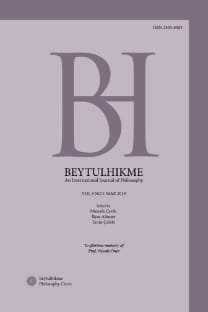Bergson'da Zaman, Kendilik ve Özgürlük
Time, the Self and Freedoom in Bergson
___
- Bergson, H. (1997). Şuurun Doğrudan Doğruya Verileri (çev. M. Ş. Tunç). İstanbul: Milli Eğitim Basımevi.
- Bergson, H. (1946). Creative Mind (trans. M. L. Andison). New York: Philosophical Library.
- Bergson, H. (1947). Yaratıcı Tekamül (çev. M. Ş. Tunç). İstanbul: Milli Eğitim Basımevi.
- Bergson, H. (2004). Ahlakın ve Dinin İki Kaynağı (çev. M. M. Yakupoğlu). Ankara: Doğubatı Yayınları.
- Bergson, H. (2004). Gülme: Komiğin Anlamı Üzerine Deneme (çev. U. C. Gökduman). İstanbul: Zeplin Kitap.
- Bergson, H. (2015). Madde ve Bellek (çev. I. Ergüden). Ankara: Dost Kitabevi.
- Cutrofello, A. (2005). Continental Philosophy: A Contemporary Introduction. New York & London: Routledge.
- Edman, I. (2005). Foreword. Bergson, H. Creative Evolution. New York: The Modern Library, ix-xviii.
- Ellison, R. (1995). Invisible Man. New York: Vintage International.
- Kant, I. (2015). Arı Usun Eleştirisi (çev. A. Yardımlı). İstanbul: İdea Yayınevi.
- Kant, I. (2016). Yargı Yetisinin Eleştirisi (çev. A. Yardımlı). İstanbul: İdea Yayınevi.
- Lawlor, L. (2003). Challenge of Bergsonism: Phenomenology, Ontology, Ethics. London & New York: Continuum.
- Lawlor, L. & Leonard, V. M. (2013). Henri Bergson. E. N. Zalta (Ed.), The Stanford Encyclopedia of Philosophy (ed. E. N. Zalta). Retrieved from https://plato.stanford.edu/archives/win2013/entries/bergson.
- Morrison, P. R. (1978). Kant, Husserl, and Heidegger on Time and the Unity of ‘Consciousness’. Philosophical and Phenomenological Research, 39 (2), 182-198.
- Mullarkey, J. (1999). Bergson and Philosophy. Notre Dame: University of Notre Dame Press.
- Platon (2016). Sokrates’in Savunması (çev. A. Çokona). İstanbul: İş Bankası Kültür Yayınları.
- Sedley D. (2003). Plato’s Cratylus. Cambridge: Cambridge University Press.
- Seigel, J. (2005). The Idea of the Self: Thought and Experience in Western Europe since the Seventeenth Century. New York: Cambridge University Press.
- ISSN: 1303-8303
- Başlangıç: 2011
- Yayıncı: Mustafa Çevik
Foucault ile Agamben Arasında: Biyopolitika Bağlamında Ötenazi So- rununa Bir Bakış
Will It Be Possible for Artificial Intelligence Robots to Acquire Free Will and Believe in God?
Yapay Zekâ Robotlarının Bir Gün Özgür İrade Edinip Tanrı'ya İnanmaları Mümkün Olacak mı?
Adalet Kavramı Konusunda Gazâlî, İbn Arâbî ve Mevlânâ’nın Görüşlerinin Analizi
BİLAL KUŞPINAR, AYŞE YAŞAR ÜMÜTLÜ
Kemalizmin Üç Yorumu: Katı, Sıvı ve Gaz Kemalizmler
The Concept of Bergsonian Time in Mansfield’s ‘Miss Brill’
Bahtin, Kant ve Danto’da Sanatın Bir İşlevi Olarak İtibarsızlaştırma
Albert Camus: Yabancı ve Sisifos Söyleni: Duygusal Bir Deney Olarak Saçmanın Düşünsel Bir Kavrama
Between Foucault and Agamben: An Overview of the Problem of Euthanasia in the context of Biopolitics
Varlığın Çobanı ya da Varlığın Duacısı: Martin Heidegger ve Nurettin Topçu Üzerine Düşünceler
